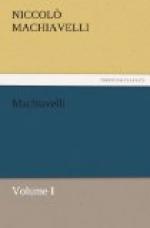Pero se aleuna volta io rido e canto
Facciol, perche non ho se non quest’
una
Via da sfogare il mio angoscioso pianto.
Vettori promised much, but nothing came of it. By 1515 the correspondence died away, and the Ex-Secretary found for himself at last the true pathway through his vale of years.
[Sidenote: The true Life.]
The remainder of Machiavelli’s life is bounded by his books. He settled at his villa at San Casciano, where he spent his day as he describes in the letter quoted at the beginning of this essay. In 1518 he began to attend the meetings of the Literary Club in the Orti Oricellarii, and made new and remarkable friends. ’Era amato grandamente da loro ... e della sua conversazione si dilettavano maravigliosamente, tenendo in prezzo grandissimo tutte l’opere sue,’ which shows the personal authority he exercised. Occasionally he was employed by Florentine merchants to negotiate for them at Venice, Genoa, Lucca, and other places. In 1519 Cardinal Medici deigned to consult him as to the Government, and commissioned him to write the History of Florence. But in the main he wrote his books and lived the daily life we know. In 1525 he went to Rome to present his History to Clement vii., and was sent on to Guicciardini. In 1526 he was busy once more with military matters and the fortification of Florence. On the 22nd of June 1527 he died at Florence immediately after the establishment of the second Republic. He had lived as a practising Christian, and so died, surrounded by his wife and family. Wild legends grew about his death, but have no foundation. A peasant clod in San Casciano could not have made a simpler end. He was buried in the family Chapel in Santa Croce, and a monument was there at last erected with the epitaph by Doctor Ferroni—’Tanto nomini nullum par elogium.’ The first edition of his complete works was published in 1782, and was dedicated to Lord Cowper.




